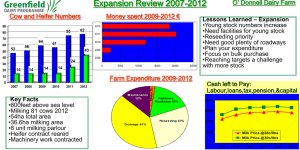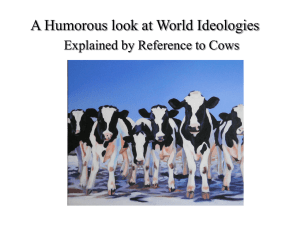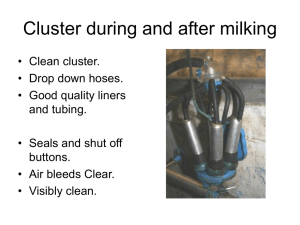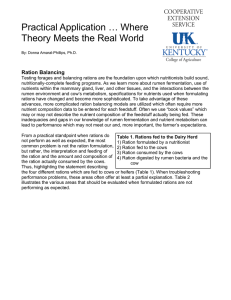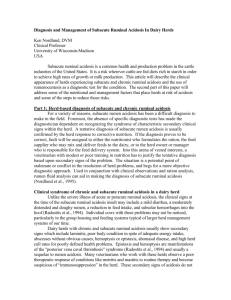Ration Formulation in Animal Nutrition
advertisement
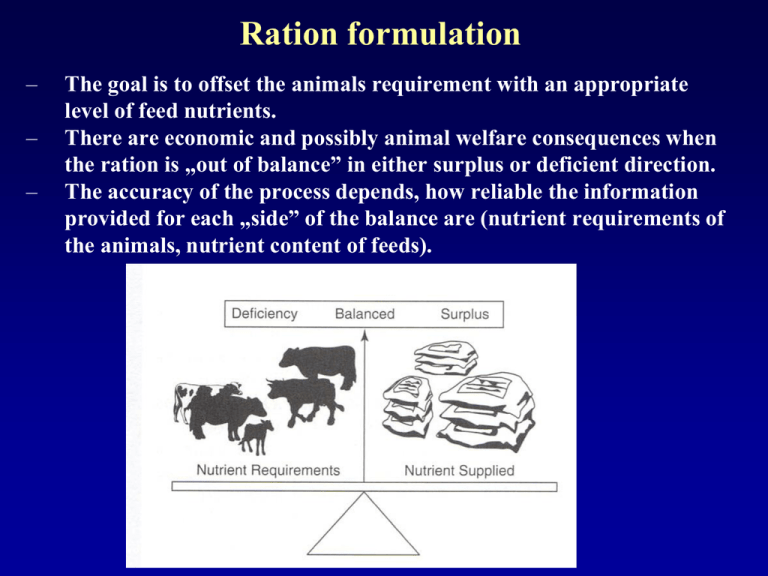
Ration formulation – – – The goal is to offset the animals requirement with an appropriate level of feed nutrients. There are economic and possibly animal welfare consequences when the ration is „out of balance” in either surplus or deficient direction. The accuracy of the process depends, how reliable the information provided for each „side” of the balance are (nutrient requirements of the animals, nutrient content of feeds). Ration formulation – There are two ways for formulation: • • – – hand methods (needs practice, practical experience, slow, does not take into account the price of feedstuffs) computer methods (quick, takes into account also the price of feedstuffs, needs also practical experience) For ruminants daily rations are prepared (daily ration for cows producing 20l milk per day) For monogastric animals compound diets are produced (diets for 3060 kg pigs) The nutrient content of feeds – can be measured in a laboratory – can be found in the same recommendations like to the requirements In the case of ruminants the following requirement values are used: – dry matter, NE, crude protein, crude fibre, Ca, P, In the case of monogastric animals: – dry matter, DE or ME, crude protein, crude fibre, Ca, P, Lysine, Methionine + Cystine Other minerals, vitamins, salt are added in the form of so called premixes Ration formulation The requirement of animals depends on the – species (feedstuffs used for the ruminants and monogastrics are different) – form of utilisation (the ration of milking cows contain more forage, on the other hand beef cattle are fed with rations containing high amounts of grains) – age of animals (young animals need more energy, protein, minerals, vitamins; requirements decline in elder animals) Requirement values can be determined or found in different recommendations (National Research Council, NRC; other national recommendations, like Hungarian Feed Codex, research publications etc.) Determination the energy, protein or amino acid requirements with animal experiments 35 30 25 20 15 10 5 0 12 12,0 12,512,8 13 13,5 MJ/kg MJ/kg MJ/kg MJ/kg MJ/kg Requirements of some animal species Energy Crude protein Ca P Beef cattle, live weight: 300 kg, daily growth rate: 800g 26,6 MJ NEm 11,6 MJ NEg 741g 29g 18g Growing diet for pigs (50 kg) 14MJ DE 170g 6g 5g Broiler grower diet (3-5 week old chicks) 13, 4 MJ ME 200g 9g 3,5g* Turkey growing diet (13 week old birds) 13,0 MJ ME 190g 7,5g 3,8g* * = non phytate, or available P Energy requirements of beef cattle Liwe weight, kg 150 200 250 300 350 400 450 500 550 600 650 44,7 - Medium frame Growth kg/day Maintenance energy requirement, NEm, MJ/day 15,8 19,6 23,2 266 29,8 33 0 360 39,0 41,9 Energy requirement of growth, NEg, MJ/day 0,4 - - - 6,1 6,8 7,4 8,0 8,6 9,2 - 0,6 5,0 6,3 74 8,5 9,5 10,5 11,5 12,5 13,4 14,3 - 0,7 6,0 7,4 8,8 10,1 11,3 12,5 13,6 14,7 15,8 16,9 - 0,8 69 8,6 10,2 11,6 13,1 14,4 15,8 17,1 18,3 19,6 - 0,9 7,9 9,8 116 13,2 14,9 16,4 18,0 19,4 20,9 22,3 - 1,0 88 11,0 13,0 14,9 16,7 18,4 20,2 21,8 23,4 25,0 - 1,1 9,8 12,2 14,4 16,5 18,5 20,5 22,4 24,2 26,0 27,8 - 1,2 10,8 13,4 158 18,2 20,4 22,5 246 26,6 28,6 - 1,3 11,8 14,6 17,3 19,8 22,3 24,6 26,9 29,1 - - 1,4 - 159 18,8 21,5 24,1 26,7 29,2 - - - - Big frame Maintenance energy requirement, NEm, MJ/day Growth kg/day 16,6 20,6 24,3 27,9 31,3 34,6 37,8 40,9 43,9 46,9 49,8 Energy requirement of growth, NEg, MJ/day 0,4 - - - - 0,6 4,5 5,6 0,8 61 0,9 70 1,0 6,5 7,1 7,6 8,1 8,6 6,6 7,5 8,4 9,3 10,2 11,0 11,9 12,7 13,4 7,6 9,0 10,3 8,7 10,2 11,7 11,6 12,8 14,0 15,1 16,3 17,4 18,4 13,2 14,6 15,9 17,2 18,5 19,7 21,0 7,8 9,7 11,5 13,2 14,8 164 179 19,3 20,8 22,2 23,5 1,1 8,7 10,8 12,8 14,6 16,4 18,2 19,8 21,5 23,1 24,6 26,1 1,2 9,6 11,9 140 16 1 18,1 20,0 21,8 23,6 25,4 27,1 28,7 1,3 10,5 13,0 15,3 17,6 197 21,8 23,8 25,8 27,7 29,6 31,4 1,0 11,3 14,1 16,6 19,0 21,4 23 7 258 28,0 300 32,1 - 1,5 12,2 15,2 17,9 20,6 23,1 25,5 27,9 30,2 32,4 - - 1,6 13,1 16,3 19,3 22,1 248 27,4 29,9 32,4 - - 1,8 - 18,5 21,9 25,1 28,2 31,2 34,0 - - Formulation daily rations for milking cows Basic ration (the roughage part of the ration, covers the maintenance requirement of cows and the production of about 10-12 l milk per day) Supplementary feed (contains cereals and protein concentrates, covers the requirement of producing milk above the basic ration) Mineral and vitamin premixes are mixed with the supplementary feed. If no supplementary feed is needed some grain meal (0,5-1 kg) is used to mix with the premixes. Formulation daily rations for milking cows 1. find out the nutrient requirement of the cow or th group of cows 2. find out the feedstuffs available 3. define the ratio of feedstuffs, according to the potential dry matter intake of cows and the recommended maximum ratios of feedstuffs 4. NEl and crude protein contents of the ration is calculated and compared with the requirements 5. Check the Ca and P supply. If necessary use Ca and P supplements. If both minerals are missing, use the P supplement first, since it contains also Ca. The final deficiency of Ca can be supplied with limestone. 6. Check the fibre content of the ration (20±3% of the dry matter intake) 7. Ruminants can feed about 8-10% green forages, 3-5% silages, and 0,5-1% hays of their live weight. Formulation daily ration for 600 kg milking cows, producing 14 litre milk per day, the milk contains 3,6% fat, grazing on good quality pasture Requirement Dry matter (kg) NEl (MJ) Crude protein (g) Ca (g) P (g) Maintenance Milk production Total Feedstuffs sz.a. Nutrients in 1 kg dry matter NEl c. prot. c. fibre Ca P (g) (MJ) corn silage (kg) 25 alfalfa hay 5 Total 30 Differences (g) (g) (g) (g) Amount dry matter (kg) Nutrients in the ration NEl c. prot. c. fibre Ca P (MJ) (g) (g) (g) (g) Maintenance requirements of cows crude protein Weight (kg) NEl, MJ Ca p g grazing 450 34,3 good quality 37,7 500 37,2 40,9 44,6 432 22 17 550 39,9 43,9 47,9 461 24 18 600 42,6 46,9 51,1 489 26 20 650 45,2 49,7 54,2 515 28 21 700 47,8 52,6 57,4 542 30 23 750 50,4 55,4 60,5 567 32 25 stall medium quality 41,2 403 19 15 Requirements of production 1 litre milk milk fat % NEl MJ milk protein % CP 3,0 2,68 2,7 77 3,5 2,87 2,8 82 3,6 2,92 2,9 83 3,7 2,96 3,0 84 3,8 3,00 3,1 85 3,9 3,04 3,2 86 4,0 3,10 3,3 87 4,1 3,13 3,4 88 Ca p g 2,8 1,7 Potential dry matter intake of dairy cows, kg (±1kg) Live weight (kg) 400 500 600 700 10,0 11,2 12,4 13,6 14,8 16,0 11,5 12,5 14,0 15,5 17,0 18,0 19,0 20,0 13,2 14,4 16,2 18,0 19,2 20,4 21,6 22',8 14,7 16,1 18,2 19,6 21,0 22,4 23,8 25,2 Milk production (kg) 10 15 20 25 30 35 40 45 - Ca and P supplements Ca Name Dry matter (g/kg) P g/kg Ca:P Amount needed for supplying 1 g P MCP (monocalcium phosphate) 908 160 220 0,73:1 4,55 DCP (dicalcium phosphate) 980 290 210 1.38:1 4,76 ÁP-17 950 225 171 1,31:1 5,85 ÁP-18 Hostaphos 950 191 187 1,02:1 5,35 950 90 175 0,51:1 5,71 Nutrafosz I. (cattle ) II. (pig) 950 87 131 0,66:1 7,63 950 184 105 1,75:1 9,52 III. (poultry) 950 170 105 1,62:1 9,52 Phylafor 950 39 121 0,32:1 8,26 Cefkaphos 950 160 227 0,70:1 4,41 Phylafor Super 950 34 180 0,19:1 5,56 Phylafor (sheep) 950 42 122 0,34:1 8,20 Limestone 950 380 - - -




